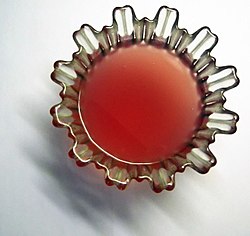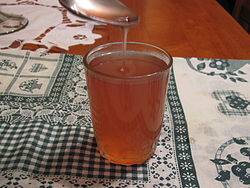Kissel
 From Wikipedia - Reading time: 14 min
From Wikipedia - Reading time: 14 min
 Fruit kissel | |
| Alternative names | Kisel, kiisseli (Finnish) Kisiel (pl. kisiele) (Polish) |
|---|---|
| Type | jelly |
| Course | dessert or drink |
| Region or state | Central and Eastern Europe, Russia and Finland |
| Main ingredients | 1) fruit juice (or puree) or milk thickened with cornstarch or potato starch; 2) grain or oat flakes |
Kissel or kisel[a] is a simple dish with the consistency of a thick gel, and made of sweet fruit, berry, grains (oatmeal, rye, wheat), peas, or from milk.[1] It belongs to the group of cold-solidified desserts,[2] although it can be served warm.
Etymology
[edit]"Kissel" is derived from a Slavic word meaning 'sour', after a similar old Slavic dish—a leavened flour porridge (or weak sourdough) which was made from grain, most commonly oats, but any grain, including legumes like peas or lentils could be used. Bean kissels were typically not leavened, and lacked the sweetness of the modern variants.[citation needed]
History
[edit]Grain-based kissels were known 9000 years ago in ancient Anatolia and Mesopotamia, they are mentioned in Sumerian and Akkadian texts.[1] In ancient times, oatmeal kissel was prepared by fermentation of oat milk.[1]
In Russia, oatmeal, rye or wheat kissel was an everyday dish, but also a ritual one, eaten at funeral feasts.[1] Hot oatmeal kissel was usually eaten with linseed or hemp oil.[1] When cooled and solidified, it was cut and served with milk, jam or with fried onions.[1]
Oat-based kissel soup is one of the characteristic national dishes of Poland (żurek) and Belarus.[1]
In old Polish cuisine, the name kisiel or kisielica was used for thick soups (slush, Polish: breja, plural breje) made of fish gelatin.[3] In French cuisine there was a similar dish known, called gelée – a berry-fruit jelly-kissel made with addition of gelatin based on fish waste.[1] Contemporary fruit kissels are solidified with starch and the preparation prosess doesn't require fermentation, therefore they are easier to make.[1] In the former Russian Empire, fruit kissels appeared in late 19th[1] century or at the beginning of 20th, when affordable potato starch became easily available.[4] In Western European languages, fruit and berry sweet kissels based on starch do not have a common name and are attributed to "fruit cereals", "gravy", "sautés", "fruit sauces" etc.[1]
Among other dishes closely related to starch-solidified kissels are: rice pudding, flummery (British cuisine), Haferschleim (German), Lokum (Turkish), polenta (Italian) or mamalyga (Eastern-Roman).[1]
-
Sourdough kissel from oat flakes and rye bread
-
"Podlaski oat kissel" entered on the Polish List of Traditional Products
Fruit kissel
[edit]Fruit kissel is a viscous dish, popular as a dessert and as a drink in Northern, Central, and Eastern Europe.[5][6] It consists of the sweetened juice (or puree[7]) of berries. Sometimes red wine, fresh, or dried fruits are added as well.[6] It is similar to mors, but usually thickened with cornstarch or potato starch; arrowroot[8] may be used as a substitute as well. The thickness varies depending on how much starch is used and on temperature. Thin kissel is most easily consumed by drinking, while thicker versions are almost like jelly and eaten with a spoon. Kissel can be served either hot or cold. Can be paired with sweetened quark or cream, can also be served on pancakes or with ice cream.
It is similar to the Danish rødgrød and German Rote Grütze.[5] Swedish blåbärssoppa is a similarly prepared bilberry dessert.[citation needed]
Today, most Polish households prepare fruit kissel from instant mixes instead of the traditional way. The most popular flavours are strawberry, gooseberry, and raspberry[citation needed]. In Russia, the most popular flavours are cranberry, cherry, and redcurrant[citation needed].
In Lithuania, cranberry kissel (Lithuanian: spanguolių kisielius[9]) is a traditional meal on Kūčios (Christmas Eve supper).
In Finland, kissel is often made of bilberries (since they can often be found growing wild in forests, and are thus both easy to gather and free) as well as from prunes, apricots, strawberries, etc. Rhubarb can also be used (see #Vegetable kissel), but is often combined with strawberries to produce a sweeter flavour. Kuningatarkiisseli ('Queen's kissel') is made with mixed berries and berry juices, generally bilberries and raspberries. Prune kissel (luumukiisseli) is traditionally eaten with rice pudding at Christmas.[citation needed]
-
Commercial strawberry flavour kissel from Poland
-
Russian syrniki with kissel
-
Ukrainian blackcurrant kissel as a drink
-
Finnish fruit kissel
-
Red currant and gooseberry kissel
Vegetable kissel
[edit]Less common, vegetable kissel is made from boiled or baked vegetables such as rhubarb,[10] pumpkins, or beetroot.[citation needed]
Milk kissel
[edit](Polish: budyń or kisiel mleczny; Finnish: maitokiisseli) is a creamy pudding, similar to semolina pudding or budino. It is made from milk and potato starch (Poland[11]) or corn starch (Finland[12]) and flavoured with sugar and vanillin (or vanilla) or cocoa powder. It can also be enriched with the addition of butter and yolks.[11]
It may be eaten as a dessert, alone, or garnished with fruit syrups, sauces, jams, fresh or dried fruit, or with cookies and biscuits.
It may also be used as an ingredient in cake creams (i.e. for karpatka or napoleonka). Most Polish households prepare milk kissel from instant mixes instead of the traditional way.
-
Milk kissel sprinkled with chocolate
-
Vanilla milk kissel with strawberries
Cultural references
[edit]
Kissel is mentioned in the Primary Chronicle, where there is a story of how it saved the city of Belgorod in Kievan Rus', besieged by nomadic Pechenegs in 997. When the food in the city became scarce, the population followed the advice of an old man, who told them to make kissel from the remnants of grain, and a sweet drink from the last mead they could find. They filled a wooden container with the kissel, and another one with the mead drink, and put those containers into the holes in the ground, and built two fake wells over them. When the Pechenegian ambassadors came into the town, they saw how the inhabitants took the food from those "wells", and the Pechenegs even were allowed to taste the kissel and mead beverage. Impressed by that show and degustation, Pechenegs decided to lift the siege and to go away, having concluded that the Ruthenians were mysteriously fed from the earth itself.[13]
In Russian fairy tales, the land of marvels (similar to Cockaigne) is described as the land of "milk rivers and kissel banks". This expression became an idiom in Russian for prosperous life or "paradise on earth".[14]
Another phrase common in Russia and Poland, "the seventh water after kissel" (Polish: siódma woda po kisielu, Russian: седьмая вода на киселе), is used to describe a distant relative.[15]
See also
[edit]Notes
[edit]- ^ Belarusian: кісель; Estonian: kissell; Finnish: kiisseli, IPA: [ˈkiːsːeli]; Latgalian: keiseļs; Latvian: ķīselis; Lithuanian: kisielius; Polish: kisiel, IPA: [ˈkʲiɕɛl] ⓘ; Russian: кисель, romanized: kiselʼ, IPA: [kʲɪˈsʲelʲ] ⓘ; Ukrainian: кисiль, romanized: kysil, IPA: [kɪˈs⁽ʲ⁾ilʲ] ⓘ.
References
[edit]- ^ a b c d e f g h i j k l Inna Vladimirovna Simakova; Victoria Nikolaevna Strizhevskaya; Roman Lvovich Perkel; Galina Yuryevna Rakhmanova (7 January 2022). "8.4.1 Technological Features of The Production of Concentrates of Desserts — Kissels". Global Production and Consumption of Fast Food and Instant Concentrates. IGI Global. pp. 217–218. ISBN 978-1-7998-8199-5. OCLC 1227864390.
- ^ Konarzewska, Małgorzata (2013). "3.3 „Desery zestalane na zimno"". Technologia gastronomiczna z towaroznawstwem: podręcznik do nauki zawodu kucharz w technikum i szkole policealnej (in Polish). Vol. 3. Wydawnictwa Szkolne i Pedagogiczne. p. 88. ISBN 978-83-02-14080-8.
- ^ "Kisiel z owoców (wiśni, malin, truskawek itd.)". Kanon kuchni polskiej: kuchnia polska: tradycja, teraźniejszość, wspólnota. Karol Krajewski (edited by), Jarosław Dumanowski and Maciej Nowicki (selection based on). Warszawa: Narodowy Instytut Kultury i Dziedzictwa Wsi. December 2019. pp. 248–249. ISBN 978-83-956204-0-9.
{{cite book}}: CS1 maint: others (link) - ^ Иосифовна, Шангина Изабелла. "Кисель" (in Russian). Russian Museum of Ethnography. Archived from the original on 2020-01-28. Retrieved 2020-01-28. [Caution: the article in section Материалы по этнографии: Русские народные праздники и обряды: Межсезонные обряды и обычаи, do not confuse with the shortened version in section Материалы по этнографии: Глоссарий]
- ^ a b The Oxford Companion to Food (2014, ISBN 019104072X), page 446
- ^ a b Encyclopedia of Contemporary Russian Culture (2013, ISBN 1136787852), page 73
- ^ Anna Szczepańska (1976). "Kisiele". In Maria Szczygłowa (ed.). Dobra kuchnia: żywienie w rodzinie (V ed.). Warszawa: Wydawnictwo „Watra”. pp. 411–414.
- ^ "Kissel Authentic Recipe | TasteAtlas". www.tasteatlas.com. Retrieved 2023-11-19.
- ^ Christiana Noyalas (Naujalis) (2013-12-12). "Kisielius (Cranberry Pudding)". Filadelfijos Lietuvių Namai. Retrieved 2023-05-23.
- ^ Natalia, Khanova (2016-11-10). "Rhubarb kissel – a peasant dessert fit for a king". Rossiyskaya Gazeta (cop.) / Russia Beyond. Retrieved 2023-01-12.
- ^ a b [video] "eDMN - scenariusz 3 - Jak zrobić domowy budyń - Zintegrowana Platforma Edukacyjna" (in Polish).
- ^ Maitokiisseli. Valio
- ^ The Russian Primary Chronicle, Laurentian Text. Translated and edited by Samuel Hazzard Cross and Olgerd P. Sherbowitz-Wetzor. Cambridge, MA: The Mediaeval Academy of America, 1953, p.122. Kissel is translated as "porridge" in this edition.
- ^ "МОЛОЧНЫЕ РЕКИ И КИСЕЛЬНЫЕ БЕРЕГА - это... Что такое МОЛОЧНЫЕ РЕКИ И КИСЕЛЬНЫЕ БЕРЕГА?". Словари и энциклопедии на Академике (in Russian). Retrieved 2021-03-13.
- ^ "седьмая вода на киселе - это... Что такое седьмая вода на киселе?". Словари и энциклопедии на Академике (in Russian). Retrieved 2021-03-13.
 KSF
KSF






